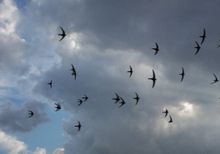Apus (bird)
Apus is a genus of birds in the family Apodidae. They are called swifts in English. Not all swifts are in genus Apus, but all birds in Apus are swifts.
| Apus | |
|---|---|

| |
| Common swifts (Apus apus) | |
| Scientific classification | |
| Domain: | Eukaryota |
| Kingdom: | Animalia |
| Phylum: | Chordata |
| Class: | Aves |
| Order: | Apodiformes |
| Family: | Apodidae |
| Subfamily: | Apodinae |
| Genus: | Apus (genus) Scopoli, 1777 |
| Species | |
|
See text | |
Taxonomy
changeItalian naturalist Giovanni Antonio Scopoli made the genus Apus in 1777. He did it by looking at tautonymy and the common swift. Carl Linnaeus named the common swift Hirundo apus in 1758.[1][2][3] The name Apus is Latin for a swift. The word is from Ancient Greek : α, a, "without," and πούς, pous, "foot." People thought they were swallows without feet.[4]
Before the 1950s, scientists disagreed about which animals should have the name Apus.[5] In 1801, Bosc gave the small crustacean animals that we call Triops today the genus name Apus, and later writers continued to use it for them. In 1909, Keilhack said this was incorrect because there was already a group of birds called Apus. It was not until 1958 that the scientists in the International Commission on Zoological Nomenclature (ICZN) decided to use the name for only birds.[6]
Species
changeThe genus has 20 species:[7]
- Cape Verde swift, Apus alexandri
- Common swift, Apus apus
- Plain swift, Apus unicolor
- Nyanza swift, Apus niansae
- Pallid swift, Apus pallidus
- African black swift, Apus barbatus
- Malagasy black swift, Apus balstoni
- Fernando Po swift Apus sladeniae
- Forbes-Watson's swift, Apus berliozi
- Bradfield's swift, Apus bradfieldi
- Pacific swift, Apus pacificus
- Salim Ali's swift, Apus salimalii
- Blyth's swift, Apus leuconyx
- Cook's swift, Apus cooki
- Dark-rumped swift, Apus acuticauda
- Little swift, Apus affinis
- House swift, Apus nipalensis
- Horus swift, Apus horus
- White-rumped swift, Apus caffer
- Bates's swift Apus batesi
Some birds in Apus are dead. Scientists learned about them from fossils, marks that their bones left in rocks:
- Apus gaillardi (Middle/Late Miocene of La Grive-St.-Alban, France)
- Apus wetmorei (Early - Late Pliocene? of SC and SE Europe)
- Apus baranensis (Late Pliocene of SE Europe)
- Apus submelba (Middle Pleistocene of Slovakia)
Scientists say the bird "Apus" ignotus is really in Procypseloides.
References
change- ↑ Scopoli, Giovanni Antonio (1777). Introductio ad historiam naturalem (in Latin). Pragae: Apud Wolfgangum Gerle. p. 483.
- ↑ Peters, James Lee, ed. (1940). Check-list of Birds of the World. Vol. 4. Cambridge, Massachusetts: Harvard University Press. p. 244.
- ↑ Linnaeus, C. (1758). Systema Naturæ per regna tria naturae, secundum classes, ordines, genera, species, cum characteribus, differentiis, synonymis, locis, Volume 1 (in Latin). Vol. 1 (10th ed.). Holmiae:Laurentii Salvii. p. 192.
- ↑ Jobling, James A (2010). The Helm Dictionary of Scientific Bird Names. London: Christopher Helm. p. 52. ISBN 978-1408125014.
- ↑ O. S. Møller; J. Olesen; J. T. Høeg (2003). "SEM studies on the early larval development of Triops crancriformis (Bosc)(Crustacea: Branchiopoda, Notostraca)". Acta Zoologica. 84 (4): 267–284. doi:10.1046/j.1463-6395.2003.00146.x.
- ↑ Hemming, Francis, ed. (1958). "Opinion 502". Opinions and Declarations Rendered by the International Commission on Zoological Nomenclature. Vol. 18. London: International Trust for Zoological Nomenclature. pp. 65–120.
- ↑ Gill, Frank; Donsker, David, eds. (2017). "Owlet-nightjars, treeswifts & swifts". World Bird List Version 7.2. International Ornithologists' Union. Retrieved 2 June 2017.